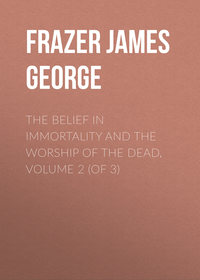 полная версия
полная версияThe Golden Bough: A Study in Magic and Religion (Third Edition, Vol. 08 of 12)
§ 3. Many Manii at Aricia
Loaves called Maniaebaked at Aricia. Woollen effigies dedicated at Rome to Mania, the Mother or Grandmother of Ghosts, at the Compitalia. The loaves at Aricia perhaps sacramental bread made in the likeness of the King of the Wood. Practice of putting up dummies to divert the attention of ghosts or demons from living peopleWe are now able to suggest an explanation of the proverb “There are many Manii at Aricia.”254 Certain loaves made in the shape of men were called by the Romans maniae, and it appears that this kind of loaf was especially made at Aricia.255 Now, Mania, the name of one of these loaves, was also the name of the Mother or Grandmother of Ghosts,256 to whom woollen effigies of men and women were dedicated at the festival of the Compitalia. These effigies were hung at the doors of all the houses in Rome; one effigy was hung up for every free person in the house, and one effigy, of a different kind, for every slave. The reason was that on this day the ghosts of the dead were believed to be going about, and it was hoped that, either out of good nature or through simple inadvertence, they would carry off the effigies at the door instead of the living people [pg 095] in the house. According to tradition, these woollen figures were substitutes for a former custom of sacrificing human beings.257 Upon data so fragmentary and uncertain, it is impossible to build with confidence; but it seems worth suggesting that the loaves in human form, which appear to have been baked at Aricia, were sacramental bread, and that in the old days, when the divine King of the Wood was annually slain, loaves were made in his image, like the paste figures of the gods in Mexico, India, and Europe, and were eaten sacramentally by his worshippers.258 The Mexican sacraments in honour of Huitzilopochtli were also accompanied by the sacrifice of human victims. The tradition that the founder of the sacred grove at Aricia was a man named Manius, from whom many Manii were descended, would thus be an etymological myth invented to [pg 096] explain the name maniae as applied to these sacramental loaves. A dim recollection of the original connexion of the loaves with human sacrifices may perhaps be traced in the story that the effigies dedicated to Mania at the Compitalia were substitutes for human victims. The story itself, however, is probably devoid of foundation, since the practice of putting up dummies to divert the attention of ghosts or demons from living people is not uncommon. As the practice is both widely spread and very characteristic of the manner of thought of primitive man, who tries in a thousand ways to outwit the malice of spiritual beings, I may be pardoned for devoting a few pages to its illustration, even though in doing so I diverge somewhat from the strict line of argument. I would ask the reader to observe that the vicarious use of images, with which we are here concerned, differs wholly in principle from the sympathetic use of them which we examined before;259 and that while the sympathetic use belongs purely to magic, the vicarious use falls within the domain of religion.
Tibetan custom of putting effigies at the doors of houses to deceive demonsThe Tibetans stand in fear of innumerable earth-demons, all of whom are under the authority of Old Mother Khön-ma. This goddess, who may be compared to the Roman Mania, the Mother or Grandmother of Ghosts, is dressed in golden-yellow robes, holds a golden noose in her hand, and rides on a ram. In order to bar the dwelling-house against the foul fiends, of whom Old Mother Khön-ma is mistress, an elaborate structure somewhat resembling a chandelier is fixed above the door on the outside of the house. It contains a ram's skull, a variety of precious objects such as gold-leaf, silver, and turquoise, also some dry food, such as rice, wheat, and pulse, and finally images or pictures of a man, a woman, and a house. “The object of these figures of a man, wife, and house is to deceive the demons should they still come in spite of this offering, and to mislead them into the belief that the foregoing pictures are the inmates of the house, so that they may wreak their wrath on these bits of wood and so save the real human occupants.” When all is ready, a priest prays to Old Mother Khön-ma that she would be pleased to accept these dainty offerings and to close the open [pg 097] doors of the earth, in order that the demons may not come forth to infest and injure the household.260
Effigies buried with the dead in order to deceive their ghostsFurther, it is often supposed that the spirits of persons who have recently departed this life are apt to carry off with them to the world of the dead the souls of their surviving relations. Hence the savage resorts to the device of making up of dummies or effigies which he puts in the way of the ghost, hoping that the dull-witted spirit will mistake them for real people and so leave the survivors in peace. Hence in Tahiti the priest who performed the funeral rites used to lay some slips of plantain leaf-stalk on the breast and under the arms of the corpse, saying, “There are your family, there is your child, there is your wife, there is your father, and there is your mother. Be satisfied yonder (that is, in the world of spirits). Look not towards those who are left in the world.” This ceremony, we are told, was designed “to impart contentment to the departed, and to prevent the spirit from repairing to the places of his former resort, and so distressing the survivors.”261 When the Galelareese bury a corpse, they bury with it the stem of a banana-tree for company, in order that the dead person may not seek a companion among the living. Just as the coffin is being lowered into the earth, one of the bystanders steps up and throws a young banana-tree into the grave, saying, “Friend, you must miss your companions of this earth; here, take this as a comrade.”262 In the Banks Islands, Melanesia, the ghost of a woman who has died in childbed cannot go away to Panoi or ghost-land if her child lives, for she cannot leave the baby behind. Hence to bilk her ghost they tie up a piece of banana-trunk loosely in leaves and lay it on her bosom in the grave. So away she goes, thinking she has her baby with her, and as she goes the banana-stalk keeps slipping about in the leaves, and she fancies it is the child stirring at her breast. Thus she is happy, till she comes to ghost-land and finds she has been deceived; for a baby of banana-stalk cannot pass [pg 098] muster among the ghosts. So back she comes tearing in grief and rage to look for the child; but meantime the infant has been artfully removed to another house, where the dead mother cannot find it, though she looks for it everywhere.263 In the Pelew Islands, when a woman has died in childbed, her spirit comes and cries, “Give me the child!” So to beguile her they bury the stem of a young banana-tree with her body, cutting it short and laying it between her right arm and her breast.264 The same device is adopted for the same purpose in the island of Timor.265 In like circumstances negroes of the Niger Delta force a piece of the stem of a plantain into the womb of the dead mother, in order to make her think that she has her babe with her and so to prevent her spirit from coming back to claim the living child.266 Among the Yorubas of West Africa, when one of twins dies, the mother carries about, along with the surviving child, a small wooden figure roughly fashioned in human shape and of the sex of the dead twin. This figure is intended not merely to keep the live child from pining for its lost comrade, but also to give the spirit of the dead child something into which it can enter without disturbing its little brother or sister.267 Among the Tschwi of West Africa a lady observed a sickly child with an image beside it which she took for a doll. But it was no doll, it was an effigy of the child's dead twin which was being kept near the survivor as a habitation for the little ghost, lest it should wander homeless and, feeling lonely, call its companion away after it along the dark road of death.268
Fictitious burials to divert the attention of demons from the real burialsAt Onitsha, a town on the left bank of the Niger, a missionary once met a funeral procession which he describes as very singular. The real body had already been buried in the house, but a piece of wood in the form of a [pg 099] sofa and covered up was being borne by two persons on their heads, attended by a procession of six men and six women. The men carried cutlasses and the women clapped their hands as they passed along each street, crying, “This is the dead body of him that is dead, and is gone into the world of spirits.” Meantime the rest of the villagers had to keep indoors.269 The sham corpse was probably intended as a lure to draw away prowling demons from the real body. So among the Angoni, who inhabit the western bank of Lake Nyassa, there is a common belief that demons hover about the dying and dead before burial in order to snatch away their souls to join their own evil order. Guns are fired and drums are beaten to repel these spiritual foes, but a surer way of baulking their machinations is to have a mock funeral and so mislead and confound them. A sham corpse is made up out of anything that comes to hand, and it is treated exactly as if it were what it pretends to be. This lay figure is then carried some distance to a grave, followed by a great crowd weeping and wailing as if their hearts would break, while the rub-a-dub of drums and the discharge of guns add to the uproar. Meantime the real corpse is being interred as quietly and stealthily as possible near the house. Thus the demons are baffled; for when the dummy corpse has been laid in the earth with every mark of respect, and the noisy crowd has dispersed, the fiends swoop down on the mock grave only to find a bundle of rushes or some such trash in it; but the true grave they do not know and cannot find.270 Similarly among the Bakundu of the Cameroons two graves are always made, one in the hut of the deceased and another somewhere else, and no one knows where the corpse is really buried. The custom is apparently intended to guard the knowledge of the real grave from demons, who might make an ill use of the body, if not of the soul, of the departed.271 In like manner the Kamilaroi tribe of Australia are reported to make two graves, a real [pg 100] one and an empty one, for the purpose of cheating a malevolent spirit called Krooben.272 So, too, some of the Nagas of Assam dig two graves, a sham grave made conspicuous on purpose to attract the notice of the evil spirits, and the real grave made inconspicuous to escape their attention: a figure is set up over the false grave.273 Isis is said to have made many false graves of the dead Osiris in Egypt in order that his foe Typhon might not be able to find the true one.274 In Bombay, if a person dies on an unlucky day, a dough figure of a man is carried on the bier with him and burnt with his corpse. This is supposed to hinder a second death from occurring in the family,275 probably because the demons are thought to take the dough figure instead of a real person.
Effigies used to cure or prevent sickness by deluding the demons of disease or inducing them to accept the effigies instead of the personsAgain, effigies are often employed as a means of preventing or curing sickness; the demons of disease either mistake the effigies for living people or are persuaded or compelled to enter them, leaving the real men and women well and whole.276 Thus the Alfoors of Minahassa, in Celebes, will sometimes transport a sick man to another house, while they leave on his bed a dummy made up of a pillow and clothes. This dummy the demon is supposed to mistake for the sick man, who consequently recovers.277 Cure or prevention of this sort seems to find especial favour with the Dyaks of Borneo. Thus, when an epidemic is raging among them, the Dyaks of the Katoengouw river set up wooden images at their doors in the hope that the demons of the plague may be deluded into carrying off the effigies instead of the people.278 Among the Oloh Ngadju of Borneo, when a sick man is supposed to be suffering from the assaults of a ghost, puppets of dough or rice-meal are made and thrown under [pg 101] the house as substitutes for the patient, who thus rids himself of the ghost. So if a man has been attacked by a crocodile and has contrived to escape, he makes a puppet of dough or meal and casts it into the water as a vicarious offering; otherwise the water-god, who is conceived in the shape of a crocodile, might be angry.279 In certain of the western districts of Borneo if a man is taken suddenly and violently sick, the physician, who in this part of the world is generally an old woman, fashions a wooden image and brings it seven times into contact with the sufferer's head, while she says: “This image serves to take the place of the sick man; sickness, pass over into the image.” Then, with some rice, salt, and tobacco in a little basket, the substitute is carried to the spot where the evil spirit is supposed to have entered into the man. There it is set upright on the ground, after the physician has invoked the spirit as follows: “O devil, here is an image which stands instead of the sick man. Release the soul of the sick man and plague the image, for it is indeed prettier and better than he.” Similar substitutes are used almost daily by these Dyaks for the purpose of drawing off evil influences from anybody's person. Thus, when an Ot Danom baby will not stop squalling, its maternal grandmother takes a large leaf, fashions it into a puppet to represent the child, and presses it against the infant's body. Having thus decanted the spirit, so to speak, from the baby into the puppet, she pierces the effigy with little arrows from a blow-gun, thereby killing the spirit that had vexed her child.280 Similarly in the island of Dama, between New Guinea and Celebes, where sickness is ascribed to the agency of demons, the doctor makes a doll of palm-leaf and lays it, together with some betel, rice, and half of an empty eggshell, on the patient's head. Lured by this bait the demon quits the sufferer's body and enters the palm-leaf doll, which the wily doctor thereupon promptly decapitates. This may [pg 102] reasonably be supposed to make an end of the demon and of the sickness together.281 A Dyak sorcerer, being called in to prescribe for a little boy who suffered from a disorder of the stomach, constructed two effigies of the boy and his mother out of bundles of clothes and offered them, together with some of the parents' finery, to the devil who was plaguing the child; it was hoped that the demon would take the effigies and leave the boy.282 Batta magicians can conjure the demon of disease out of the patient's body into an image made out of a banana-tree with a human face and wrapt up in magic herbs; the image is then hurriedly removed and thrown away or buried beyond the boundaries of the village.283 Sometimes the image, dressed as a man or a woman according to the sex of the patient, is deposited at a cross-road or other thoroughfare, in the hope that some passer-by, seeing it, may start and cry out, “Ah! So-and-So is dead”; for such an exclamation is supposed to delude the demon of disease into a belief that he has accomplished his fell purpose, so he takes himself off and leaves the sufferer to get well.284 The Mai Darat, a Sakai tribe of the Malay Peninsula, attribute all kinds of diseases to the agency of spirits which they call nyani; fortunately, however, the magician can induce these maleficent beings to come out of the sick person and take up their abode in rude figures of grass, which are hung up outside the houses in little bell-shaped shrines decorated with peeled sticks.285
Effigies used to divert the attention of demons in Nias and various parts of AsiaIn the island of Nias people fear that the spirits of murdered infants may come and cause women with child to miscarry. To divert the unwelcome attention of these sprites from a pregnant woman an elaborate mechanism has been contrived. A potent idol called Fangola is set up beside her bed to guard her slumbers during the hours of darkness from [pg 103] the evil things that might harm her; another idol, connected with the first by a chain of palm-leaves, is erected in the large room of the house; and lastly a small banana-tree is planted in front of the second idol. The notion is that the sprites, scared away by the watchful Fangola from the sleeping woman, will scramble along the chain of palm-leaves to the other idol, and then, beholding the banana-tree, will mistake it for the woman they were looking for, and so pounce upon it instead of her.286 In Bhutan, when the Lamas make noisy music to drive away the demon who is causing disease, little models of animals are fashioned of flour and butter and the evil spirit is implored to enter these models, which are then burnt.287 So in Tibet, when a man is very ill and all other remedies have failed, his friends will sometimes, as a last resort, offer an image of him with some of his clothes to the Lord of Death, beseeching that august personage to accept the image and spare the man.288 A Burmese mode of curing a sick man is to bury a small effigy of him in a tiny coffin, after which he ought certainly to recover.289 In Siam, when a person is dangerously ill, the magician models a small image of him in clay and carrying it away to a solitary place recites charms over it which compel the malady to pass from the sick man into the image. The sorcerer then buries the image, and the sufferer is made whole.290 So, too, in Cambodia the doctor fashions a rude effigy of his patient in clay and deposits it in some lonely spot, where the ghost or demon takes it instead of the man.291 The same ideas and the same practices prevail much further to the north among the tribes on the lower course of the River Amoor. When a Goldi or a Gilyak shaman has cast out the devil that caused disease, an abode has to be provided for the homeless devil, and this is done by making [pg 104] a wooden idol in human form of which the ejected demon takes possession.292
Effigies used to divert ghostly and other evil influence from people in ChinaThe Chinese of Amoy make great use of cheap effigies as means of diverting ghostly and other evil influence from people. These effigies are kept in stock and sold in the shops which purvey counterfeit paper money and other spurious wares for the use of simple-minded ghosts and gods, who accept them in all good faith instead of the genuine articles. Nothing could well be cruder than the puppets that are employed to relieve sufferers from the many ills which flesh is heir to. They are composed of two bamboo splinters fastened together crosswise with a piece of paper pasted on one side to represent a human body. Two other shreds of paper, supposed to stand for boots, distinguish the effigy of a man from the effigy of a woman. Armed with one of these “substitutes for a person,” as they are called, you may set fortune at defiance. If a member of your family, for example, is ailing, or has suffered any evil whatever, or even is merely threatened by misfortune, all that you have to do is to send for one of these puppets, pass it all over his body while you recite an appropriate spell, and then burn the puppet. The maleficent influence is thus elicited from the person of the sufferer and destroyed once for all. If your child has tumbled into one of those open sewers which yawn for the unwary in the streets, you need only fish him out, pass the puppet over his filthy little body, and say: “This contact (of the substitute) with the front of the body brings purity and prosperity, and the contact with the back gives power to eat till an old, old, old age; the contact with the left side establishes well-being for years and years, and the contact with the right side bestows longevity; happy fate, come! ill fate, be transferred to the substitute!” So saying you burn the substitute, by choice near the unsavoury spot where the accident happened; and if you are a careful man you will fetch a pail of water and wash the ashes away. Moreover, the child's head should be shaven quite clean; but if the sufferer was an adult, it is enough to lay bare with the razor [pg 105] a small patch on his scalp to let out the evil influence.293 In Corea effigies are employed on much the same principle for the purpose of prolonging life. On the fourteenth and the fifteenth day of the first month all men and women born under the Jen or “Man” star make certain straw images dressed in clothes and containing a number of the copper cash which form the currency of the country. Strictly speaking, there should be as many cash in the image as the person whom it represents has lived years; but the rule is not strictly observed. These images are placed on the path outside the house, and the poor people seize them and tear them up in order to get the cash which they contain. The destruction of the image is supposed to save the person represented from death for ten years. Accordingly the ceremony need only be performed once in ten years, though some people from excess of caution appear to observe it annually.294
Effigies used as substitutes to save the lives of people among the Abchases of the Caucasus and the Ewe negroes of West AfricaThe Abchases of the Caucasus believe that sickness is sometimes caused by Mother Earth. So in order to appease her and redeem the life of the sick man, an innocent maiden will make a puppet in human form, richly clad, and bury it in the earth, saying, “Instead of the sick man, play and delight yourself with this.”295 The Ewe negroes of Togoland, in West Africa, think that the spirits of all living people come from heaven, where they live in the intervals between their incarnations. Life in Amedzowe, as they call that heavenly region, which lies a little to the east of the town of Ho, is very like life on earth. There are fields there and wildernesses and forests. Also there are all kinds of food, such as yams and maize and likewise stock-yams, not to speak of cotton; in fact, all these things came from heaven just as men themselves did. Moreover, everybody has his spiritual mother in heaven and his spiritual aunt, also his spiritual uncle, his spiritual grandfather, and [pg 106] so on, just as on earth. Now the spirits in heaven are apt to resent it when one of their number quits them to go and be born as a child on earth; and sometimes they will pursue the truant and carry him back to the celestial country, and that is what we call death. Little children are most commonly fetched away by their mother in heaven; for she wearies for them and comes and lays an invisible hand on the child, and it sickens and dies. If you hear a child whimpering of nights, you may be sure that its mother from heaven has laid her hand on it and is drawing it away to herself. If the child grows very sick and its earthly mother fears that it will die, she will mould two figures of clay, a man and a woman, and offer them in exchange to the heavenly mother, saying, “O thou bearer and mother of children! instead of the child that has gone away from thee we bring thee here in exchange these clay men. Take them and withdraw thy hand from the child in this visible world.” Grown-up people also, when they fall sick, will sometimes make images of clay and offer them as substitutes to the messengers who have come from heaven to fetch them away. These images are deposited with other offerings, such as cowry-shells and a musket, by the roadside; and if the messengers accept them instead of the sick man, he recovers.296 During an epidemic of small-pox the Ewe negroes will sometimes clear a space outside of the town, where they erect a number of low mounds and cover them with as many little clay figures as there are people in the place. Pots of food and water are also set out for the refreshment of the spirit of small-pox who, it is hoped, will take the clay figures and spare the living folk; and to make assurance doubly sure the road into the town is barricaded against him.297
Effigies used as substitutes to save the lives of people among the Nishga IndiansAmong the Nishga Indians of British Columbia when [pg 107] a medicine-man dreams a dream which portends death to somebody, he informs the person whose life is threatened, and together they concert measures to avert the evil omen. The man whose life is at stake has a small wooden figure called a shigigiadsqu made as like himself as the skill of the wood-carver will allow, and this he hangs round his neck by a string so that the figure lies exactly over his heart. In this position he wears it long enough to allow the heat of his body to be imparted to it, generally for about four days. On the fourth day the medicine-man comes to the house, arrayed in his bearskin and other insignia of office and bringing with him a wisp of teased bark and a toy canoe made of cedar-bark. Thus equipped, he sings a doleful ditty, the death-song of the tribe. Then he washes the man over the region of the heart with the wisp of bark dipped in water, places the wisp, together with the wooden image, in the canoe, and after again singing the death-chant, commits image, wisp, and canoe to the flames, where they are all consumed. The death-chant is now changed to a song of joy, and the man who was lately in fear of his life joins in. He may well be gay, for has he not given death the slip by devoting to destruction, not merely a wisp saturated with the dangerous defilement of his body, but also a substitute made in his own likeness and impregnated with his very heart's warmth?298










